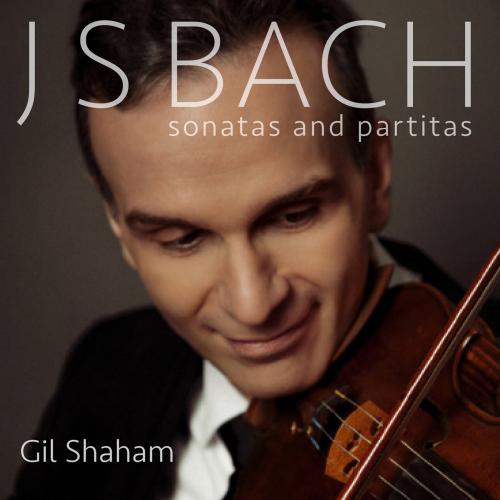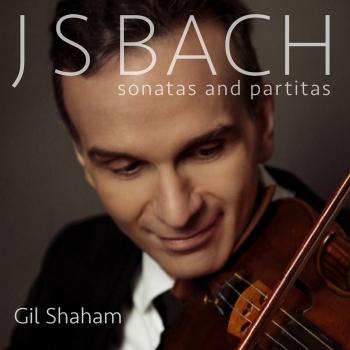
Bach: Sonatas and Partitas, BWV 1001 - BWV 1006 Gil Shaham
Album info
Album-Release:
2015
HRA-Release:
25.07.2019
Label: Canary Classics
Genre: Classical
Artist: Gil Shaham
Composer: Johann Sebastian Bach (1685-1750)
Album including Album cover Booklet (PDF)
- Johann Sebastian Bach (1685 - 1750): Sonata for Violin No. 1 in G Minor, BWV 1001:
- 1 Sonata for Violin No. 1 in G Minor, BWV 1001: I. Adagio 03:11
- 2 Sonata for Violin No. 1 in G Minor, BWV 1001: II. Fuga (Allegro) 04:14
- 3 Sonata for Violin No. 1 in G Minor, BWV 1001: III. Siciliana 02:40
- 4 Sonata for Violin No. 1 in G Minor, BWV 1001: IV. Presto 03:31
- Partita for Violin No. 1 in B Minor, BWV 1002:
- 5 Partita for Violin No. 1 in B Minor, BWV 1002: I. Allemanda 03:53
- 6 Partita for Violin No. 1 in B Minor, BWV 1002: II. Double 02:37
- 7 Partita for Violin No. 1 in B Minor, BWV 1002: III. Corrente 02:58
- 8 Partita for Violin No. 1 in B Minor, BWV 1002: IV. Double (Presto) 03:41
- 9 Partita for Violin No. 1 in B Minor, BWV 1002: V. Sarabande 02:58
- 10 Partita for Violin No. 1 in B Minor, BWV 1002: VI. Double 02:02
- 11 Partita for Violin No. 1 in B Minor, BWV 1002: VII. Tempo di Borea 03:05
- 12 Partita for Violin No. 1 in B Minor, BWV 1002: VIII. Double 03:18
- Sonata for Violin No. 2 in A Minor, BWV 1003:
- 13 Sonata for Violin No. 2 in A Minor, BWV 1003: I. Grave 03:07
- 14 Sonata for Violin No. 2 in A Minor, BWV 1003: II. Fuga 06:45
- 15 Sonata for Violin No. 2 in A Minor, BWV 1003: III. Andante 04:08
- 16 Sonata for Violin No. 2 in A Minor, BWV 1003: IV. Allegro 05:14
- Partita for Violin No. 2 in D Minor, BWV 1004:
- 17 Partita for Violin No. 2 in D Minor, BWV 1004: I. Allemanda 03:36
- 18 Partita for Violin No. 2 in D Minor, BWV 1004: II. Corrente 02:18
- 19 Partita for Violin No. 2 in D Minor, BWV 1004: III. Sarabanda 03:01
- 20 Partita for Violin No. 2 in D Minor, BWV 1004: IV. Giga 03:54
- 21 Partita for Violin No. 2 in D Minor, BWV 1004: V. Ciaccona 11:12
- Sonata for Violin No. 3 in C Major, BWV 1005:
- 22 Sonata for Violin No. 3 in C Major, BWV 1005: I. Adagio 02:57
- 23 Sonata for Violin No. 3 in C Major, BWV 1005: II. Fuga 08:14
- 24 Sonata for Violin No. 3 in C Major, BWV 1005: III. Largo 02:54
- 25 Sonata for Violin No. 3 in C Major, BWV 1005: IV. Allegro assai 05:05
- Partita for Violin No. 3 in E Major, BWV 1006:
- 26 Partita for Violin No. 3 in E Major, BWV 1006: I. Preludio 03:21
- 27 Partita for Violin No. 3 in E Major, BWV 1006: II. Loure 03:10
- 28 Partita for Violin No. 3 in E Major, BWV 1006: III. Gavotte en Rondeau 02:54
- 29 Partita for Violin No. 3 in E Major, BWV 1006: IV. Menuet I, Menuet II 04:01
- 30 Partita for Violin No. 3 in E Major, BWV 1006: V. Bourée 01:29
- 31 Partita for Violin No. 3 in E Major, BWV 1006: VI. Gigue 01:52
Info for Bach: Sonatas and Partitas, BWV 1001 - BWV 1006
J.S. Bach's Sonatas and Partitas for solo violin are considered by many as the pinnacle of musical achievement, arguably the composer's most demanding and emotionally penetrating works. After living with, reading about, listening to and playing these seminal works for over 30 years Gil Shaham offers a fresh and vital new perspective on these works, undertaken in 2014 as part of his Artist-in-Residence with Symphonieorchester des Bayerischer Rundfunk.
J.S. Bach has influenced every generation of composer and musician. Here Shaham’s insight and bold originality speaks to his willingness to take interpretative risks, while his innate musicianship and warmth – what Musical America calls his “special kind of humanism” – ensures that his performances bring out the partitas’ dancing rhythms along with their soul. ‘I find the music an amazing spiritual experience. There’s something very uplifting about this music’, says Shaham. For this recording he has decided on a ‘more Baroque set-up’ opting for a Baroque bridge, Baroque bow and 3 of 4 strings being gut.
When asked what effect this set-up has on his interpretation Gil Shaham indicated that ‘it changes every stroke, but it doesn’t really change general ideas of interpretation. You can do everything with both sets of bow and bridge, although some things are easier with the modern bow, some with the Baroque one. The “small softness” (coined by Leopold Mozart) is easier with the Baroque bow.
The tempos Gil Shaham has settled on in this recording are also quite different from what one might expect. Shaham takes inspiration from other works by Bach, as he explains; ‘if you compare the French minuet from Partita No.3, with say the minuet from a French suite, or even the famous ‘Anna Magdalena’ minuet I found myself asking myself wouldn’t it work better at the same tempo as the others? The Baroque bow is lighter and is easier to play faster.
"...Shaham's playing is so clean, clear and precise, and the thought behind everything he plays so unassailable, that to listen to it is to
feel safe with music...it is impossible to listen to it without having a positive artistic experience." (Gramophone)
"...Violinist Gil Shaham has taken up Baroque-style bow and gut strings, but this is no typical period style. Long years of playing Bach's six great solo works for violin have led Shaham to a personal and free way of playing... there is much detail and nimble, sensitive violin playing on the way." (Richard Fairman, Financial Times)
"Shaham's playing sparkles with vitality and and astonishes with its technical brilliance...this is a rewarding achievement of which the C major Sonata is its dazzling high point...vibrato is thoughtfully applied." (BBC Music Magazine)
Gil Shaham, violin
Gil Shaham
is one of the foremost violinists of our time, whose combination of flawless technique with inimitable warmth and a generosity of spirit has solidified his legacy as an American master. He is sought after throughout the world for concerto appearances with leading orchestras and conductors, and he regularly gives recitals and ensemble appearances on the great concert stages and at the most prestigious festivals.
In the 2012-13 season, Shaham continues his long-term exploration of “Violin Concertos of the 1930s,” a project beginning in 2010 and comprising performances at some of the most well-established concert venues with the world’s greatest orchestras. “Violin Concertos of the 1930s,” including the Barber, Berg, Stravinsky and Britten Violin Concertos, as well as the Bartok Violin Concerto No. 2 and the Prokofiev Violin Concerto No. 2, will be performed with the Orchestras of Baltimore, Boston, New York, Chicago, Montreal, San Francisco and Kansas City and abroad with the Orchestre de Paris and the NHK Symphony. In the coming months, Shaham will release his first recording tied to the project on his label, Canary Classics, which includes the Barber, Stravinsky and Berg Violin Concertos with three leading orchestras under the baton of David Robertson. Beyond “Violin Concertos of the 1930s,” Shaham returns to other favorite repertoire this season; pieces include the Brahms concerto with the Los Angeles Philharmonic, Philadelphia Orchestra and Cincinnati Symphony, the Beethoven concerto with the Boston and St. Louis Symphony Orchestras, and Mozart’s “Turkish” concerto with the Pittsburgh, Toronto and Seattle Symphony Orchestras. The season kicked off with a busy summer that included performances at Caramoor, Aspen, the Blossom Festival, Tanglewood and the Hollywood Bowl. In April 2013, Canary Classics will release Nigunim, a new CD – featuring Shaham alongside his sister, pianist Orli Shaham – that celebrates the “soulful melodies” of their Jewish heritage.
Shaham is also an avid recitalist and chamber musician. During recital tours in the US, Europe and Japan, Shaham explores new work including the world premiere of a solo suite written for him by William Bolcom and the recent commissioned duo works by Avner Dorman and Julian Milone with Akira Euguchi on piano. This season also sees Shaham return to Bach’s Sonatas and Partitas for solo violin, bringing his unique approach to these beloved works with an eye towards releases the complete work on CD in the coming seasons.
Last season, Shaham’s highlights included engagements in New York with three different world class orchestras including performances of the Brahms concerto at Carnegie Hall with the Cleveland Orchestra and Orpheus Chamber Orchestra and the Hartmann Concerto Funebre with the New York Philharmonic. Other high profile enegagements include performances with Boston, San Francisco, London, New World and Atlanta Smyphonies, a Japan tour with Mariss Jansons and the Concertgebouw Orchestra, the Tonhalle Orchestre, as well as residencies with Orchestre de Paris and Berlin. Shaham has more than two dozen concerto and solo CDs to his name, including bestsellers that have appeared on record charts in the US and abroad. These recordings have earned prestigious awards, including multiple Grammys, a Grand Prix du Disque, Diapason d’Or, and Gramophone Editor’s Choice. His recent recordings are produced on the Canary Classics label, which he founded in 2004. They comprise Haydn Violin Concertos and Mendelssohn’s Octet with Sejong Soloists; Sarasate: Virtuoso Violin Works with Adele Anthony, Akira Eguchi and Orquesta Sinfónica de Castilla y León; Elgar’s Violin Concerto with the Chicago Symphony Orchestra and David Zinman; The Butterfly Lovers and Tchaikovsky’s Violin Concerto with the Singapore Symphony; Tchaikovsky’s Piano Trio in A with Yefim Bronfman and cellist Truls Mork; The Prokofiev Album and Mozart in Paris, both with Orli Shaham; and The Fauré Album with Akira Eguchi and cellist Brinton Smith. Upcoming titles include several installments of his “Concerto of the 30’s” project and Hebrew Melodies, an exploration by Gil and Orli Shaham of both traditional and modern Jewish music, including the world-premiere recording of Israeli composer Avner Dorman’s new work “Niggunim,”
Gil Shaham was born in Champaign-Urbana, Illinois, in 1971. He moved with his parents to Israel, where he began violin studies with Samuel Bernstein of the Rubin Academy of Music at the age of seven, receiving annual scholarships from the America-Israel Cultural Foundation. In 1981, while studying with Haim Taub in Jerusalem, he made debuts with the Jerusalem Symphony and the Israel Philharmonic. That same year he began his studies with Dorothy DeLay and Jens Ellerman at Aspen. In 1982, after taking first prize in Israel’s Claremont Competition, he became a scholarship student at Juilliard, where he worked with DeLay and Hyo Kang. He also studied at Columbia University.
Shaham was awarded an Avery Fisher Career Grant in 1990, and in 2008 he received the coveted Avery Fisher Award. He plays the 1699 “Countess Polignac” Stradivarius. Shaham lives in New York City with his wife, violinist Adele Anthony, and their three children.
Booklet for Bach: Sonatas and Partitas, BWV 1001 - BWV 1006












